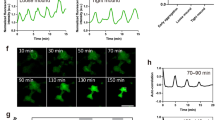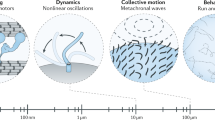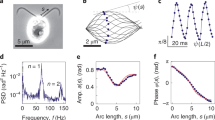Abstract
IN CERTAIN ciliated epithelia, for example, mussel gill lateral cell epithelium, metachronally coordinated ciliary beat can be arrested systematically, either after nervous1 or local stimulation, for example by laser microinjury2,3. In the latter case, the velocity of spread of arrest, its extent and decremental character suggest that the response depends on electrotonic coupling of the gill cells3. The lateral cells are coupled by extensive septate junctions and small gap junctions4, more basally located, which may act in a manner homologous to electrical synapses of nerve and muscle cells5–7. Although intracellular microelectrode recordings of lateral cell depolarisation accompanying arrest after branchial nerve stimulation have been made in Mytilus1, there are no reports of microelectrode studies of cell coupling in gill cells. We have used experimentally-induced spreading arrest to monitor the state of coupling in the lateral cell epithelium of a freshwater mussel (for example, Elliptio complanatus).
This is a preview of subscription content, access via your institution
Access options
Subscribe to this journal
Receive 51 print issues and online access
$199.00 per year
only $3.90 per issue
Buy this article
- Purchase on Springer Link
- Instant access to full article PDF
Prices may be subject to local taxes which are calculated during checkout
Similar content being viewed by others
References
Murakami, A., and Takahashi, K., Nature, 257, 48–49 (1975).
Satir, P., Fong, I., and Goldstein, S. F., Acta Protozool., 11, 287–290 (1972).
Motokawa, T., and Satir, P., J. Cell Biol., 66, 377–391 (1975).
Gilula, N. B., and Satir, P., J. Cell Biol., 51, 869–872 (1971).
Furshpan, E. J., and Potter, D. D., J. Physiol., Lond., 145, 289–324 (1959).
Loewenstein, W. R., Ann. N. Y. Acad. Sci., 137, 441–472 (1966).
Satir, P., and Gilula, N. B., A. Rev. Ent., 18, 143–166 (1973).
Satir, P., Science, 190, 586–588 (1975).
Rose, B., and Loewenstein, W. R., Nature, 254, 250–252 (1975).
Rose, B., and Loewenstein, W. R., Science, 190, 1204 (1975).
Goldstein, S. F., J. exp. Biol., 51, 431–441 (1971).
Author information
Authors and Affiliations
Rights and permissions
About this article
Cite this article
SATIR, P., REED, W. & WOLF, D. Ca2+-dependent arrest of cilia without uncoupling epithelial cells. Nature 263, 520–521 (1976). https://doi.org/10.1038/263520a0
Received:
Accepted:
Issue Date:
DOI: https://doi.org/10.1038/263520a0
This article is cited by
-
Calcium regenerative potentials inMytilus edulis gill abfrontal ciliated epithelial cells
Journal of Comparative Physiology A (1984)
-
Ca2+-dependent hormonal stimulation of ciliary activity
Nature (1980)
Comments
By submitting a comment you agree to abide by our Terms and Community Guidelines. If you find something abusive or that does not comply with our terms or guidelines please flag it as inappropriate.



